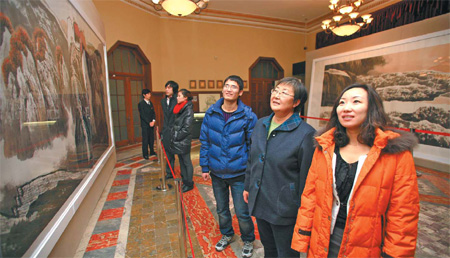Biz Unusual
Stock that paints a pretty and profitable picture for investors
By Li Jing (China Daily)
Updated: 2011-04-08 15:41
 |
Large Medium Small |
|
 |
|
Autumn in Fortress (left) and Roaring Yellow River, both by Bai Gengyan, were displayed on Jan 9 before being listed for trading on the Tianjin Cultural Artwork Exchange. [Photo / China Daily] |
Shares rise as traders master the art, reports Li Jing in Beijing.
What is the easiest way to boost the price of a painting? The answer, at least in China, is probably by listing the artwork on an art exchange where its shares are traded.
That's what happened to two paintings - Roaring Yellow River (Huang He Pao Xiao) and Autumn in Fortress (Yan Sai Qiu) - on the Tianjin Cultural Artwork Exchange.
Since the initial offerings in January, shares in each of the two paintings soared to 18 times the opening price by mid-March, when regulators suspended trading for five days after excessive speculation.
A string of revisions to the exchange's trading rules caused prices to plunge, but shares of Roaring Yellow River traded at 12.24 yuan ($1.84) on April 7, compared with the issue price of 1 yuan. That put the value of the artwork, painted in 2000, at 73.34 million yuan.
Shares of Autumn in Fortress, painted in 2005, closed at 12.11 yuan on the same day, for a value of 60.55 million yuan.
That gave Shandong-born painter Bai Gengyan, who died in 2007, a sudden rise from obscurity. His best record at public auction stood at 3.92 million yuan.
Both artworks are traditional Chinese landscape paintings, something of Bai's specialty. The exchange keeps confidential any information regarding who actually possesses the paintings, at the owner's request.
While some call this trading a financial innovation for the art market, others worry that such emerging art exchanges in China will lead to just another wave of investment mania following last year's bubbles, and bursts, for garlic, apples and mung beans.
New but not unique
Tianjin Cultural Artwork Exchange (TCAE) did not invent the idea of trading artworks as stocks.
Last year, Shenzhen Artvip Cultural Corp offered to sell 1,000 shares of an art portfolio comprising 12 paintings by contemporary artist Yang Peijiang on the government-sponsored Shenzhen Cultural Assets and Equity Exchange.
The shares sold out on the first day, reaping 2.4 million yuan.
The Tianjin exchange went a step further by allowing the shares to be traded daily, so the investors could profit from short-term movements in price.
Take Roaring Yellow River, for instance. Two appraisal firms, invited by TCAE, put the value at 6 million yuan, so the exchange divided the painting into 6 million shares, at 1 yuan each, for the initial public offering on Jan 26.
Accredited buyers can open accounts and acquire shares through the online trading platform, which is much like a stock exchange system. TCAE set daily price limits to restrict fluctuation and suspend the market when trading becomes especially volatile.
In addition to paintings, the exchange allows trading of calligraphy, sculpture, artistic handicrafts, jade wares, porcelain, antique furniture and other items after authentication. A pink diamond is the only item being traded now that's not a painting.
Though the exchange is privately owned, TCAE said it has won special support from Tianjin municipal government and was listed as one of the city's top 20 projects for financial innovation in 2009. The exchange was registered in September that year, but it took more than a year to start operations.
Not exactly 'stock'
The fledgling idea of an art exchange is difficult to define, even for some veteran art collectors and investors in China.
"Strictly speaking, you cannot call it 'art stock' even though it is traded in a way very similar to the stock market," said Hu Yousheng, general manager of Hai Guo Tou Industry Share Co Ltd, who is also an experienced investor in the art market.
"Stock" refers to a certificate that represents part ownership of a company and the right to receive a share in its profits. Shareholders can make decisions to buy or sell based on the company's performance, he explained to the magazine Weekly on Stocks.
In comparison, the future of any artwork, without a specific index to measure its growth and returns, is more unpredictable and unstable.
"The trading rules set by TCAE, particularly the day-trading part, make the idea extremely appealing to the medium and small investors, especially those who have some experience in the stock market," Hu said.
Other analysts worry that the lack of regulation and supervising bodies, the immature trading rules of such "art stocks", as well as the ambiguity in some valuation processes are extremely conducive to sparking speculation.
| 分享按钮 |



